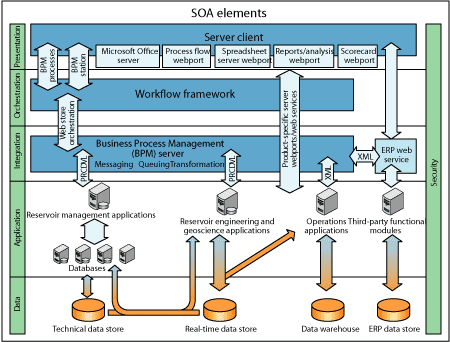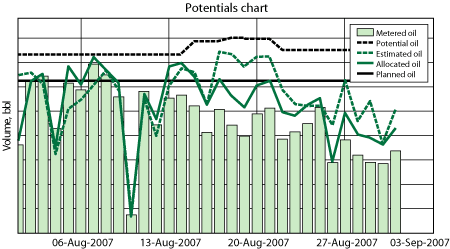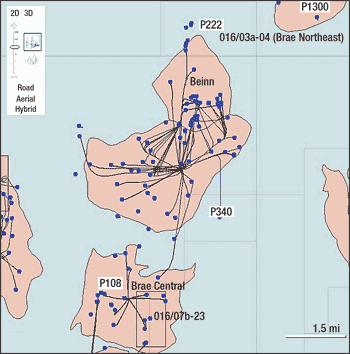A solution for improving production optimization through enhanced decision support proves its business value and reveals new information management opportunities.
Andrew Sekulin and Marty Henderson, Marathon Oil; Barry Irani and Ben Parker, The Information Store; and Mike Sternesky, Microsoft
In the second half of 2007, Marathon Oil launched a digital oilfield Proof Of Concept (POC) for its North Sea assets. The objective was to clearly demonstrate the business value of improving production decisions by making engineering information easier to find, access and share across the organization. The successful four-month POC was the result of combining the right technology and information management practices as well as receptivity to change and willingness to explore new paths within the company.
DEFINING THE DIGITAL OIL FIELD
The term digital oil field means different things to different people and organizations. For Marathon’s digital oilfield deployment it was decided to focus on some key aims:
- Providing timely, quality information to support production critical decisions
- Reducing the burden of finding necessary information
- Promoting collaboration by providing the same information to users throughout the organization.
Marathon realized that these aims could be met by providing one place to go for key business, production and operational information. This central data source would:
- Be accessible from anywhere at any time
- Integrate data from multiple data sources
- Use “mashup” web parts to combine engineering and production data in visual and composite forms
- Be customizable to meet the differing needs of different roles.
As an international, integrated oil and gas company, Marathon identified a need for a solution framework that could be applied to all areas of its upstream business. With diverse operations around the world, a “one size fits all” approach cannot accommodate the full range of business requirements. Yet standardization can reduce cost and time to implement. The company realized it needed the benefits of both a standardized solution and fit-for-purpose functionality.
Prior to the digital oilfield POC, IT decision makers at Marathon had already decided that the project should build on its core IT technologies and partnerships, and had identified several Microsoft technologies to assist with information delivery. In particular, the Microsoft Office SharePoint Server 2007 portal framework provided a standard approach in connecting users with the information they needed.
Using off-the-shelf and custom web parts, the server would enable solutions to quickly be customized to meet the unique requirements of each business unit. Furthermore, by fully embracing Service-Oriented Architecture (SOA) and the ability to simultaneously connect to multiple data sources, the server would support virtual integration of a full spectrum of E&P data and documents, Fig. 1. Leveraging Marathon’s existing server initiative, the digital oilfield POC team was able to quickly jump-start the project with an eye toward standardizing future digital oilfield solutions on the same platform.
 |
|
Fig. 1. The service-oriented architecture enables Marathon’s digital oilfield solution to virtually integrate multiple information systems.
|
|
PROVING THE CONCEPT
In the second half of 2007, Marathon launched a digital oilfield POC. The critical success factor in measuring the effectiveness of the POC was to demonstrate the business value of better decision making through access to better information.
Typically, business critical information and engineering data are isolated in vertical data silos, such as structured databases, data historians and unstructured data sources like documents and spreadsheets. Data may be accessible only to a small set of users, who are familiar with the storage location. The project team looked to prove that by improving the access to business information from where it was already stored and presenting it through easily accessible web pages, the entire business team would benefit.
Previous approaches to integration of various data sources had focused on integrating at the data layer, by creating a master data store and moving or copying data into it. The POC approach was to integrate data at the visualization layer instead of the data layer. This was expected to allow the solution to be implemented more quickly while giving developers the flexibility to connect to existing underlying data sources without moving data or hard-coding. This approach would also deliver a seamless user experience as the organization’s back-end information systems evolved, providing asset team members continuity whether engineering data was stored in a dozen places or in a master data store.
The Information Store was selected to assist Marathon in development of the POC, due to the data management company’s experience developing similar solutions for other oil companies, its knowledge of the server environment, and the E&P industry-focused PetroTrek brand of tools and web parts that it had previously developed.
Marathon’s Brae asset was selected for the POC. Producing from multiple fields in the UK sector of the North Sea, three Brae platforms serve dozens of wells and several subsea tiebacks, with processing and export facilities. Because the fields have been producing continually for up to 25 years, the asset team is now focused on optimizing declining production. The asset’s maturity also provided an excellent environment to test the digital oilfield strategy: It had a wealth of production, well and operational data stored in a variety of current and legacy systems, coupled with a dedicated asset team that was receptive to change.
The POC project team was geographically dispersed, with the program manager, developers, IT sponsor and corporate decision makers located in Houston. The project sponsor and asset team were located in Aberdeen. Production and subsurface members of the Brae area asset team were involved in the project and provided crucial feedback for determining the POC’s success.
Rather than adhering to the traditional “waterfall” development model-in which the solution would have to progress sequentially through analysis, design, testing and implementation phases-development of Marathon’s digital oilfield POC was iterative, emphasizing an agile methodology and face-to-face communication. Working closely with production and subsurface engineers, the development team gathered requirements and quickly implemented functionality in a live data environment. Based on feedback from these asset team members, new requirements could be generated and additional changes rapidly implemented. This development model helped ensure that the solution correctly addressed the asset team’s daily information needs.
Through initial close collaboration between the project team and the asset personnel, it was quickly determined that significant benefits could be realized for the Brae asset by focusing on production data and well information, which would help support ongoing production optimization activities. This also aligned with an existing asset goal to leverage opportunities for real-time production optimization.
PROOF OF CONCEPT DELIVERED
The iterative approach allowed the POC to be delivered within 4 months of project initiation, while close collaboration between the project and asset teams allowed the project to focus on the key aims of demonstrating the applicability and potential benefits of the digital oilfield approach. As a result, the POC has demonstrated the significant potential of a digital oilfield approach that integrates data at the visualization level. The experience and learning from the POC has also allowed Marathon to appreciate what can be achieved, explore development approaches, validate the server-based architecture and identify potential pitfalls in future developments.
To show how a digital oilfield solution can be delivered, the POC developed a web portal for users that seamlessly provides integrated data displays from multiple live data sources. The users need not worry about where the data is stored; the system does that for them.
The POC portal includes separate pages for Asset, Platform, Field and Well, which are accessed by tabs at the top of the page. A map page also provides a geographical interface.
On the asset and platform pages, total production is displayed in both table and chart form, using data taken directly from the existing Brae production reporting system. The table is annotated with colors highlighting wells that have deviated by more than defined percentages from the weekly average.
The iterative approach to project delivery enabled an additional display of “impact” wells to be included on the asset page; it shows all wells meeting certain production criteria, in order of production flowrates.
The POC illustrated how integrating data from multiple sources could improve accessibility to performance data. The production targets and actual production data are stored in separate systems, requiring manual intervention to compare daily production against targets. The POC showed how data from these sources could be combined in the visualization layer to provide a live monitor of performance against targets, without the need for intensive manual intervention, Fig. 2.
 |
|
Fig. 2. Key performance indicators combine multiple data sources to show a composite view of a field’s production potential.
|
|
The well page displays data for the selected well. This includes well-header and location data, production data, well intervention history and most recent well test data. Again, data are sourced from a number of different systems, and integrated only when the user calls up the well page.
The map page provides an interactive map interface that displays data from a range of sources. Using Microsoft Virtual Earth to provide the web-based Geographic Information System (GIS) capabilities, data from Marathon’s systems are overlaid on the interactive map view to provide field outlines, well, platform and pipeline locations and license information, Fig. 3. Integration with the production reporting system allows oil and gas production to be displayed on the map for each well, while clicking on the well provides a link to the appropriate well page.
 |
|
Fig. 3. A web-based GIS map helps Marathon’s asset team visualize the context of Brae Field, its platforms, wells and other facilities.
|
|
The POC process has also allowed the requirements for successful delivery of a full rollout to be understood before initiating a full implementation. This includes the requirement to ensure that critical data is of sufficient quality and in a suitable structured data store. Data buried in unstructured electronic documents, such as spreadsheets and word processing documents, cannot be readily integrated and displayed, and data on paper or microfiche is clearly a problem. The POC also highlighted the requirement to have consistent names for platforms, wells and fields within the applications from which data is being accessed. The determination of these consistent keys for wells across the various disciplines provided the additional benefit of increased collaboration across the various departments as they all saw the potential benefit of a complete digital oilfield solution.
This learning has shone a spotlight on some of the existing data quality issues, and has given added impetus to a range of initiatives that aim to develop a master well-header database, and to digitize, sort and structure legacy data that is not in a suitable form for delivery through such a system.
POTENTIAL AND NEXT STEPS
More important than the details of the POC implementation is the learning from the POC process, which has rapidly provided Marathon with a basis for development of a corporate digital oilfield strategy. Within that strategy, Marathon has decided to name the visualization component “ViewPoint.” Staff members in different roles analyze the same information, including managers, production engineers, reservoir engineers and geologists.
The POC has demonstrated the potential and value of providing ready access to integrated views of data that currently reside in separate systems acting as data silos. The implementation methodology selected has demonstrated that by integrating data at the visualization layer, the required views can be developed rapidly, without the need for massive re-engineering of the underlying data storage systems.
The availability of the POC as a demonstration system has allowed many people within the organization to familiarize themselves with the visualization system, and helped to develop a picture of the potential for application across a wide range of business functions in multiple business units within Marathon. For example, with the development of a full first-phase implementation of the visualization strategy for the UK now at definition phase, the experience of developing a relatively simple POC portal is leading users and subject matter experts to request inclusion of well-defined elements in the final system. The POC has also allowed the project team to clearly understand the implementation requirements of each requested element, reducing expected project delivery times.
Within a year from the start of the POC, Marathon has developed a corporate strategy for development of a digital oilfield solution and is moving forward with a company-wide rollout of the ViewPoint digital oilfield solution, expanding on the architecture and methodology developed through the POC. Marathon is currently implementing digital oilfield solutions for its UK assets, LNG operations in Equatorial Guinea and Gulf of Mexico operations.
Based on the learning from the POC, three guiding principles have been identified for Marathon’s digital oilfield approach:
- Access data from where it is already stored and managed (system of record)
- Select information technology that builds on existing strategies and partnerships and can be applied across the enterprise
- Generate intuitive, user-oriented displays that integrate data from multiple sources.
With these criteria in mind, the company is positioning the digital oil field as the central component of its decision-making model, bridging the gap between strategic and operational decision support. By establishing a consistent knowledge-sharing framework through its digital oilfield visualization solution, the company is demonstrating a commitment to providing quality information throughout the enterprise, for better decisions, optimal performance and greater return on oil and gas assets. 
|
THE AUTHORS
|
| |
Andrew Sekulin is Senior Performance Improvement Advisor for Marathon’s international production unit. He is responsible for coordinating the company’s UK strategy to enhance the quality and availability of business critical data in support of production optimization activities. Mr. Sekulin has worked for Marathon for 11 years, with a range of experience including safety, operations support and performance improvement projects. He has worked in Marathon’s assets in the UK, Ireland and Equatorial Guinea. In his current role, he works closely with both the corporate IT team and the UK operations support group. He has a bachelor’s degree in physics from Manchester University and a master’s degree in safety engineering and risk management from Aberdeen University.
|
|
| |
Marty Henderson is Digital Oilfield Program Manager for Marathon. His primary responsibility is managing and coordinating project activities for Marathon’s worldwide digital oilfield implementations. Mr. Henderson has worked for Marathon for 28 years, with IT experience including service delivery, infrastructure support and application development. He also led a Marathon Center of Excellence. While in the company’s audit group, he had the opportunity to learn about different business components within Marathon. Mr. Henderson holds an MS degree in computer science from Bowling Green State University in Ohio.
|
|
| |
Barry Irani brings more than three decades of petroleum industry experience to The Information Store. Mr. Irani spent the bulk of his career at Enserch Exploration Inc., where he served in various senior management positions including Chief Engineer, Senior Vice President of US Operations and Executive Vice President of Worldwide Operations. His responsibilities included acquisitions and divestitures, interaction with the financial community and raising capital in the equity markets through a public stock offering. He is a distinguished lecturer for the Society of Petroleum Engineers and has served as lecturer at the University of Texas at Dallas and Southern Methodist University in Dallas. He earned a bachelor’s degree in physics and chemistry from the University of Bombay, as well as BS and MS degrees in petroleum engineering from the University of Oklahoma.
|
|
| |
As a PetroTrek Product Development Manager at The Information Store, Ben Parker is responsible for web development and marketing of the product. He brings 15 years in oil and gas IT, web development and an educational background in psychology to create web-based solutions that are relevant and intuitive for oil and gas workers. Mr. Parker’s career includes work with UpstreamInfo.com, as a principal for WorldSpinner Web Development and Parker Geophysical Services. He earned a bachelor’s degree in psychology from Stephen F. Austin University, specializing in human factors involved with user interface design. He also completed post-graduate study in philosophy at Texas A&M University.
|
|
| |
Michael Sternesky is the Energy Solutions Manager for Microsoft’s Houston-based US oil and gas business. He has been engaged in the energy industry for 27 years. Before joining Microsoft, Mr. Sternesky was the Vice President of Business Development for Knowledge Reservoir. Prior to that position, he served as Vice President of Sales at UpstreamInfo. His career also includes 20 years with the Royal Dutch Shell Group, where he worked in a variety of leadership positions. In his last five years at Shell, Sternesky worked for Shell Services International, Shell’s services and IT arm, where he was Vice President for New Ventures in the Americas. He is chairman of the Society of Petroleum Engineers’ Reservoir Study Group for the 2008 program year. Mr. Sternesky holds a bachelor’s degree in accounting from St. John’s University and an MBA degree from New York University.
|
|
| |
|
|





